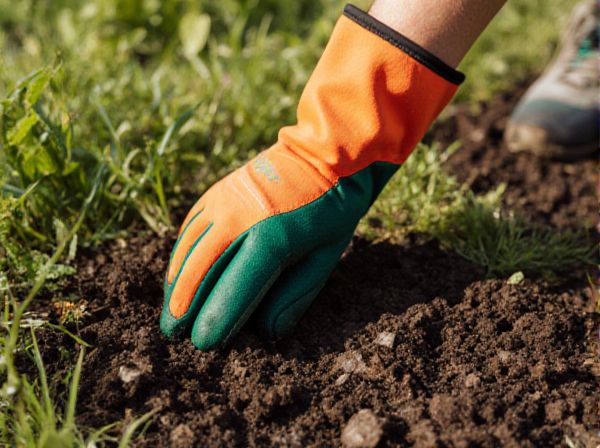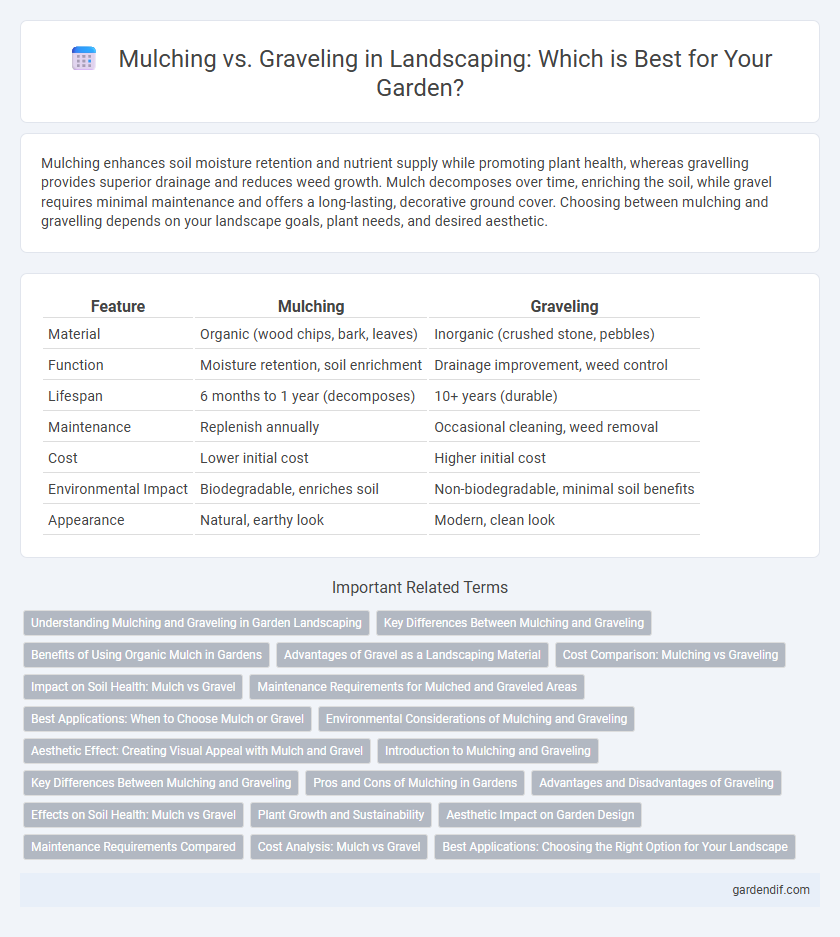
Mulching vs Graveling Illustration
Mulching enhances soil moisture retention and nutrient supply while promoting plant health, whereas gravelling provides superior drainage and reduces weed growth. Mulch decomposes over time, enriching the soil, while gravel requires minimal maintenance and offers a long-lasting, decorative ground cover. Choosing between mulching and gravelling depends on your landscape goals, plant needs, and desired aesthetic.
Table of Comparison
| Feature | Mulching | Graveling |
|---|---|---|
| Material | Organic (wood chips, bark, leaves) | Inorganic (crushed stone, pebbles) |
| Function | Moisture retention, soil enrichment | Drainage improvement, weed control |
| Lifespan | 6 months to 1 year (decomposes) | 10+ years (durable) |
| Maintenance | Replenish annually | Occasional cleaning, weed removal |
| Cost | Lower initial cost | Higher initial cost |
| Environmental Impact | Biodegradable, enriches soil | Non-biodegradable, minimal soil benefits |
| Appearance | Natural, earthy look | Modern, clean look |
Understanding Mulching and Graveling in Garden Landscaping
Mulching enhances soil moisture retention, temperature regulation, and weed suppression by applying organic or inorganic materials such as wood chips or bark. Graveling provides excellent drainage, durability, and low maintenance by using small stones or pebbles that prevent soil erosion and reduce water pooling. Choosing between mulching and graveling depends on specific garden requirements, climate conditions, and aesthetic preferences in landscape design.
Key Differences Between Mulching and Graveling
Mulching involves applying organic materials like wood chips or bark to improve soil moisture retention, temperature regulation, and nutrient enrichment, while graveling uses inorganic stones to enhance drainage and provide a low-maintenance, durable ground cover. Mulches decompose over time, enriching the soil, whereas gravel remains stable, preventing weed growth without altering soil quality. The choice between mulching and graveling depends on landscape goals such as aesthetic preferences, soil health improvement, and maintenance requirements.
Benefits of Using Organic Mulch in Gardens
Organic mulch enhances soil health by improving moisture retention, regulating temperature, and adding essential nutrients as it decomposes. It supports beneficial microbial activity and earthworm populations, which contribute to better soil structure and fertility. Unlike gravel, organic mulch also helps suppress weeds effectively while promoting a more vibrant and sustainable garden ecosystem.
Advantages of Gravel as a Landscaping Material
Gravel offers superior drainage, preventing water accumulation and reducing soil erosion in landscaped areas. Its durability withstands heavy foot traffic and harsh weather conditions, ensuring long-lasting ground cover. Gravel also requires minimal maintenance, deterring weed growth and providing a clean, polished appearance in various landscape designs.
Cost Comparison: Mulching vs Graveling
Mulching generally costs between $50 and $100 per cubic yard, making it a more affordable option for large garden areas, while graveling typically ranges from $75 to $150 per ton, often resulting in higher initial expenses. Mulch requires regular replacement every 1-3 years, adding to long-term costs, whereas gravel is more durable and demands minimal upkeep, potentially offering better value over time. Landscape designers consider local material prices and installation complexity when advising on cost-effective solutions for specific project needs.
Impact on Soil Health: Mulch vs Gravel
Mulching improves soil health by enhancing moisture retention, promoting beneficial microbial activity, and adding organic matter that decomposes into nutrients. Graveling, while reducing weed growth and improving drainage, can lead to soil compaction and limit organic material incorporation, negatively affecting soil fertility over time. Choosing mulch supports a healthier, more balanced soil ecosystem, whereas gravel may hinder long-term soil vitality.
Maintenance Requirements for Mulched and Graveled Areas
Mulched areas require regular replenishment, typically every 1-2 years, to maintain moisture retention and prevent weed growth, while graveling offers lower maintenance with occasional raking and weed control using landscape fabric. Mulch decomposes over time, enriching the soil but necessitating periodic replacement, whereas gravel remains stable but may need infrequent topping up due to displacement. Both methods demand some weed management, but gravel tends to resist weed penetration better when properly installed.
Best Applications: When to Choose Mulch or Gravel
Mulch is best applied in garden beds and around trees to retain soil moisture, regulate temperature, and improve soil fertility through organic decomposition. Gravel suits pathways, driveways, and drainage areas where durability, erosion control, and low maintenance are priorities. Selecting mulch or gravel depends on landscape function, aesthetic preference, and environmental conditions such as soil type and moisture levels.
Environmental Considerations of Mulching and Graveling
Mulching enriches soil health by decomposing organic matter, enhancing moisture retention, and reducing erosion, positively impacting local ecosystems. Graveling, while durable and low-maintenance, can disrupt soil aeration and water infiltration, potentially harming microbial activity and plant growth. Choosing organic mulch over gravel supports biodiversity and carbon sequestration, making it a more eco-friendly landscaping option.
Aesthetic Effect: Creating Visual Appeal with Mulch and Gravel
Mulching enhances landscape aesthetics by providing rich, natural tones that enrich plant colors and create a unified, organic look. Graveling offers a modern, clean appearance with varied textures and hues, accentuating hardscape features and promoting a minimalist style. Combining mulch and gravel can balance warmth and structure, elevating the visual appeal through contrasting elements in garden design.
Mulching vs Graveling Infographic

 gardendif.com
gardendif.com